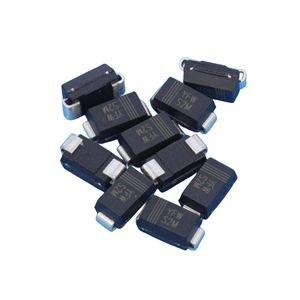Date:2024-10-30 Categories:Product knowledge Hits:310 From:Guangdong Youfeng Microelectronics Co., Ltd
Transistors and diodes are common electronic components that play important roles in circuits. A transistor has three pins, namely base, emitter, and collector, while a diode only has two pins, namely positive (anode) and negative (cathode). Under normal circumstances, each pin of a transistor needs to work properly in order to function properly. But if one pin of the transistor is broken, can it be used as a diode?
Firstly, let's understand the basic working principles of transistors and diodes.
A transistor is an electronic device with amplification function, and its working principle is based on the regulation of forward and reverse currents of a PN junction. PN junction is composed of P-type semiconductor and N-type semiconductor. The three pins of a transistor represent different regions, with the base being the control pin, the emitter being the input pin, and the collector being the output pin. By providing a small current in the base emitter circuit, the amplified current from the collector emitter circuit can be controlled.
A diode is an electronic device with unidirectional conductivity, and its working principle is based on the unidirectional conductivity of a PN junction. Forward current can flow through a diode, causing it to conduct, while reverse current can hardly flow through the diode, causing it to cut off.
In daily practice, sometimes diodes are needed to replace some of the functions of transistors. Because diodes have only two pins and are relatively simple, it may be easier to compensate for the problem of a transistor losing one pin. However, it depends on which pin is broken.
If the transistor loses its base pin, it cannot be used as a diode. This is because the base pin plays a role in controlling the input signal in the transistor. Without the base pin, the transistor will not be able to amplify the input signal. For this reason, it is not possible to use a transistor with a disconnected base pin as a diode.
If the transistor loses either the emitter pin or the collector pin, the situation may be different. Because the emitter and collector pins are mainly responsible for the flow of current in a transistor, we can try using the disconnected pins as part of the diode.
In this case, we can take the following steps to use the transistor with a broken pin as a diode.
Firstly, we need to confirm whether the disconnected pin is still connected to other pins. If they are still connected together, it means they are still sharing current with other components in the circuit.
Then, we need to determine the polarity of the conversion to the diode. One of the pins of the transistor is P-type, while the other is N-type. Based on the location of the broken pin, we can determine which semiconductor material it is connected to. If connected to a P-type material, we will obtain a P-type diode; If connected to an N-type material, we will obtain an N-type diode.
Next, we can use the disconnected pin as one pin of the diode, while the other pins that are still connected are used as the other pin. In this way, we can use the disconnected transistor pin as a diode pin.
It is worth noting that when using a transistor with a broken pin as a diode, its performance may be limited and ideal diode characteristics may not be achieved. Because there are some differences in structure and working principle between transistors and diodes, even from a structural perspective, transistors may have additional characteristics such as capacity and resistance, which need to be carefully considered when in use.
When using a transistor with a broken pin as a diode, we should also be aware of some risks. Due to the possibility of introducing unexpected results in the circuit caused by broken pins, it may lead to circuit damage or adversely affect performance. Therefore, when using it, we should conduct tests on relevant circuit test benches and adjust the circuit design according to the actual situation.
In summary, although in some cases, we can use a transistor with a broken pin as a diode instead, it should be noted that its performance may be limited and should be used with great caution. In any circuit design, it is recommended to use specialized diodes to achieve the required functionality to ensure the stability and reliability of the circuit.

Previous: Classification, Structure, and Principle of MOSFET
Next: Using voltage inspection method to quickly locate fault points in integrated circuits